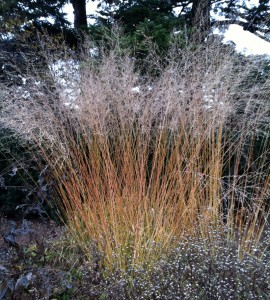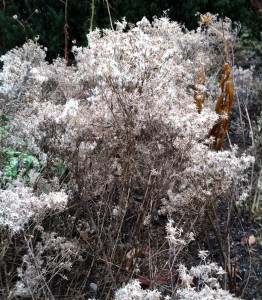Winter Comes to Seasonal Walk
Posted in Horticulture on December 16 2014, by Sonia Uyterhoeven
Sonia Uyterhoeven is NYBG‘s Gardener for Public Education.

While most of the Garden is being put to bed, our Seasonal Walk—designed by Piet Oudolf—is still putting on a notable display as the winter approaches. This is thanks to Oudolf’s naturalistic design which incorporates many plants that senesce well and provide interest even after they’ve passed their seasonal prime.
A week or two ago I was working on the Seasonal Walk, tidying up the border with my colleague, Katie Bronson, and we were admiring some of the sturdier perennials that still looked good even into December. One of the most striking features of the Walk at the onset of the hibernal months is the tall purple moor grass (Molinia caerulea ssp. arundinacea ‘Transparent’). This grass played an important role earlier in the season as it shot up to nearly six feet, towering over many of its neighboring perennial brethren. ‘Transparent’ has airy flowers with an open habit and long-lasting seedheads.
The stems of ‘Transparent’ turn into a vision of glowing embers late in the season, when they take on golden, orange, and raspberry hues. Those of you with a watchful eye may have noticed as you strolled down the border that some of the stems on certain grasses were upright, sturdy, and colorful, while other, similar grasses looked somewhat worse for wear and had only golden yellow stems. Katie told me that along with ‘Transparent’, some tall more grass (Molinia arundinacea ‘Skyracer’) had been planted. Presumably these plants will be removed in the spring and replaced with more ‘Transparent’. It was difficult to distinguish the two during the growing season, but their disparities became apparent in the fall.
There could be a number of reasons why two different grasses were planted. It’s possible that the nursery we ordered from ran out of ‘Transparent’ and sent us a substitute. There is always the chance that it was mislabeled somewhere along the way, too. Alternatively, we might have miscalculated on the numbers that we needed. I am sure ‘Skyracer’ will find a comfortable home next spring and there will be continuity in the border with the addition of more ‘Transparent’.

For homeowners who like the upright, vertical accent that moor grass provides, along with its airy blooms, but who aren’t in the market for something as tall as the two grasses mentioned above, then Molinia caerulea ‘Moorhexe’ is your answer. Known as witch’s moor grass, it reaches only two and a half to three feet tall. The narrow, black-brown flower heads turn a lovely golden color toward the end of the season, and this grass intermingles beautifully with mountain fleece flower (Persicaria amplexicaulis ‘Alba’) and foxglove-beardtongue (Penstemon digitalis ‘Husker Red’) in our border.
It’s not just the grasses that have been looking good late in the season, either. The seedheads of the hyssop leaf thoroughwort (Eupatorium hyssopifolium) look like fluffy white clouds hovering above scrawny brown stems. The dried brown stems of the rusty foxglove (Digitalis ferruginea) rise like spires above another white haze created by the dried seedheads of Hervey’s aster (Eurybia × herveyi). Winter will eventually take its toll on these pleasant sights, but they’ve definitely had a good run this season.


Dear Sonia,
I look forward to your postings because I always learn something new. I keep your pieces in my special Garden folder and read them over again. Thank you
Sue